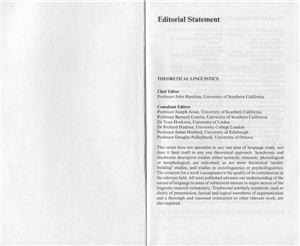Routledge, 2007 (Revised 1991 edition). - 210 p.
ISBN-10: 0415056551.
978-0415056557.
This book is the first comprehensive treatment of the phonological system of Basque available in English. Basque is a morphologically rich and fairly regular language with a number of active phonological rules that are limited to certain morphological environments. In addition, it has a high degree of dialectical fragmentation. These characteristics of Basque make this language a good test ground to investigate the interaction of phonological rules both with each other and with morphological processes, which the author does within the Lexical Phonology framework. The effects of rule interaction on feature geometry are a major conce - how phonological operations modify underlying structures and how the structures created by one phonological rule can serve as input to other rules. These effects are examined in a study of the rather peculiar behaviour of Basque affricates. Another area which requires particular attention, and in which Basque dialects differ widely, is prosody. Along with stress-accent systems of different types, Basque also possesses pitch-accent or restricted tonal systems in some of its weste dialects. This book should be of interest to advanced students and teachers of linguistics, especially Romance linguistics and lexical phonology.
ISBN-10: 0415056551.
978-0415056557.
This book is the first comprehensive treatment of the phonological system of Basque available in English. Basque is a morphologically rich and fairly regular language with a number of active phonological rules that are limited to certain morphological environments. In addition, it has a high degree of dialectical fragmentation. These characteristics of Basque make this language a good test ground to investigate the interaction of phonological rules both with each other and with morphological processes, which the author does within the Lexical Phonology framework. The effects of rule interaction on feature geometry are a major conce - how phonological operations modify underlying structures and how the structures created by one phonological rule can serve as input to other rules. These effects are examined in a study of the rather peculiar behaviour of Basque affricates. Another area which requires particular attention, and in which Basque dialects differ widely, is prosody. Along with stress-accent systems of different types, Basque also possesses pitch-accent or restricted tonal systems in some of its weste dialects. This book should be of interest to advanced students and teachers of linguistics, especially Romance linguistics and lexical phonology.

